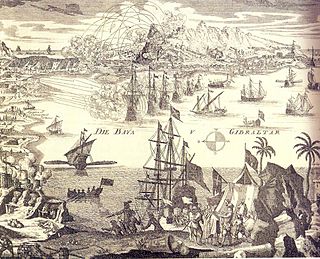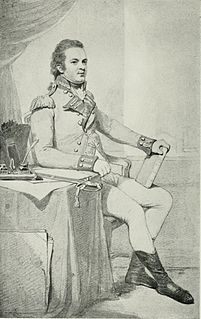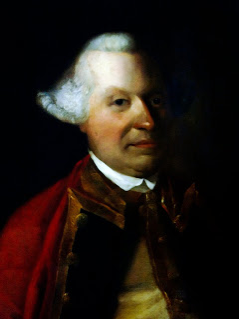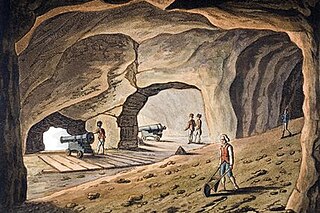 W
WThe Action of 19 January 1799 was a minor naval battle of the French Revolutionary Wars fought in waters of the Strait of Gibraltar, off Punta Europa. A Spanish squadron of 14 gunboats with a mistico as flagship, commanded by Francisco Mourelle de la Rua, attacked a British merchant convoy escorted by several Royal Navy warships, among them a 74-gun ship of the line. The British warships failed to defend the convoy, losing a gunboat sunk and another captured. The convoy also lost a ship and two brigs. For this action Mourelle de la Rua was promoted to frigate captain.
 W
WOperation Algeciras was a foiled Argentine plan to sabotage a Royal Navy warship in Gibraltar during the Falklands War. The Argentine reasoning was that if the British military felt vulnerable in Europe, they would decide to keep some vessels in European waters rather than send them to the Falklands.
 W
WThe Anglo-Spanish War of 1727–1729 was a limited war that took place between Great Britain and Spain during the late 1720s, and consisted of a failed Spanish attempt to capture Gibraltar and a unsuccessful British blockade of Porto Bello. It eventually ended with a return to the previous status quo ante bellum following the Treaty of Seville.
 W
WAntonio Barceló y Pont de la Terra was a Spanish mariner, lieutenant general of the Spanish Royal Armada.
 W
WColonel John Drinkwater Bethune (1762–1844), born John Drinkwater, was an English army officer, administrator and military historian, known for his account of the Great Siege of Gibraltar that came out in 1785.
 W
WThe Ceremony of the Keys event is a re-enactment of the locking of the gates to the old Town and garrison of Gibraltar.
 W
WSurgeon Lieutenant-Commander Bruce Cooper was a native of Castle Eden, England. He obtained his medical degree from Durham University. Early in his career, he tended to coalminers and joined the Royal Naval Volunteer Reserve. The physician served with distinction in the early period of the Second World War and was mentioned in despatches. In 1941, he was recruited for a highly classified mission, Operation Tracer. In the event that Gibraltar was taken by the Axis powers, he was to be sealed into a secret chamber in the Rock of Gibraltar with five other men for about a year and report the movements of enemy vessels. Over a period of two years, the secret complex was completed and the team assembled and trained. However, the mission was never activated. Cooper returned to England and served in both civilian and military capacities. The location of the secret chamber remained a mystery for decades, but was finally discovered in 1997. However, many questions remained, including the identity of the team members. Upon Cooper's return to Gibraltar in 2008, he confirmed that the cave in question was that which had been destined for himself and his five colleagues. Dr Cooper was the last surviving team member of Operation Tracer in Gibraltar.
 W
WLieutenant-Commander Lionel Kenneth Phillip Crabb,, known as Buster Crabb, was a Royal Navy frogman and MI6 diver who vanished during a reconnaissance mission around a Soviet cruiser berthed at Portsmouth Dockyard in 1956.
 W
WThe Naval Armament vessel formerly RFA Bedenham was a naval armament carrier that exploded while docked in Gibraltar on 27 April 1951, killing 13 people and causing a great deal of damage to the town.
 W
WThe naval battle of Gibraltar took place on 25 April 1607, during the Eighty Years' War, when a Dutch fleet surprised and engaged a Spanish fleet anchored at the Bay of Gibraltar. During the four hours' of action, most of the Spanish ships were destroyed.
 W
WThe Battle of Gibraltar took place on 10 August 1621, during the Eighty Years' War between the Spanish Empire and the Dutch Republic. A Dutch East India Company fleet, escorted by a squadron under Willem Haultain de Zoete, was intercepted and defeated by nine ships of Spain's Atlantic fleet under Fadrique de Toledo while passing the Strait of Gibraltar.
 W
WThe 1943 Gibraltar Liberator AL523 crash was an aircraft crash that resulted in the death of General Władysław Sikorski, the commander-in-chief of the Polish Army and Prime Minister of the Polish government-in-exile. Sikorski's Liberator II crashed off Gibraltar almost immediately after takeoff on 4 July 1943. An estimated sixteen people died, including many other senior Polish military leaders. The plane's pilot was the only survivor.
 W
WGeneral Sir William Green, 1st Baronet, of Marass, Kent was an officer in the British Army.
 W
WHenry Ince (1736–1808) was a sergeant-major in the British Army who achieved fame as the author of a plan to tunnel through the North Face of the Rock of Gibraltar in 1782, during the Great Siege of Gibraltar. As a result of his work, by the end of the 18th century Gibraltar had almost 4,000 feet (1,200 m) of tunnels in which dozens of cannons were mounted overlooking the isthmus linking the peninsula to Spain. He was one of the first members of the Soldier Artificer Company, a predecessor to today's Royal Engineers, and rose to be the Company's senior non-commissioned officer. He was also a founder of Methodism in Gibraltar through his activities as a Methodist lay preacher. Ince spent most of his life in the Army and served for 36 years in Gibraltar before retiring to Devon four years before he died at the age of 72.
 W
WThe Main Guard is a historic, 18th-century guardhouse in the British Overseas Territory of Gibraltar. While the exact date of its construction is unknown, it is the oldest building in John Mackintosh Square. The French artist Henri Regnault produced three paintings while a visitor at the Main Guard. After being displayed at the guardhouse for many years, they are now kept at the Gibraltar Museum. The building's function has changed with the centuries. The Main Guard first served as a guardhouse; in the 20th century, it functioned as a fire station, bath house, and government offices. Since 2001, the building has housed the Gibraltar Heritage Trust and underwent restoration in 2011.
 W
WMiddle Hill is a hill in the British Overseas Territory of Gibraltar. It is located at the northern end of the Upper Rock Nature Reserve. It figured prominently in the early history of the 1704 siege of Gibraltar by the Spanish and French. The artillery battery at Middle Hill had been constructed by 1727 and was active for more than two centuries. In the mid twentieth century, Middle Hill transitioned to use as an aerial farm for the Ministry of Defence. The radio farm was refurbished in 1958. About 1970, the Princess Caroline's Battery Group of Barbary macaques were moved to Middle Hill, where they were provisioned at a group of derelict buildings that were part of the battery complex. In 2005, much of Middle Hill was transferred from the Ministry of Defence to the Government of Gibraltar, and is now managed by the Gibraltar Ornithological and Natural History Society.
 W
WAugust de la Motte was a Hanoverian general who notably served in the Great Siege of Gibraltar.
 W
WHMS Rooke was a shore establishment of the British Armed Forces in Gibraltar from 1946 to 1990.
 W
WWładysław Sikorski's death controversy revolves around the death of the commander-in-chief of the Polish Army and Prime Minister of the Polish government in exile, General Władysław Sikorski, in the 1943 B-24 crash in Gibraltar. Sikorski's Liberator II crashed off Gibraltar almost immediately after take off, with the plane's pilot being the only survivor. The catastrophe, while officially classified as an accident, has led to several conspiracy theories that persist to this day, and often propose that the crash was an assassination, which has variously been blamed on the Soviets, British, and even Nazis. The incident is still described by some historians as mysterious, and was investigated by the Polish Institute of National Remembrance. They concluded that the injuries sustained were consistent with a plane crash and that there was not enough evidence to support or reject the theory that the plane was deliberately sabotaged.
 W
WThe Soldier Artificer Company was a unit of the British Army raised in Gibraltar in 1772 to work on improving the fortifications there. It was the Army's first unit of military artificers and labourers – the existing Corps of Engineers was entirely made up of commissioned officers – and it replaced the traditional but unreliable practice of employing civilian craftsmen. The company was an immediate success and was responsible for upgrading the British fortress's defences before the Great Siege of Gibraltar.
 W
WThe Trafalgar Cemetery is a cemetery in the British Overseas Territory of Gibraltar. Formerly known as the Southport Ditch Cemetery, it occupies a small area of land just to the south of the city walls, in what had been a defensive ditch during the period of Spanish rule of Gibraltar. Although it is named for the Battle of Trafalgar of 21 October 1805, only two victims of the battle are buried there. The remainder of the interments are mostly of those killed in other sea battles or casualties of the yellow fever epidemics that swept Gibraltar between 1804 and 1814. In addition, tombstones were transferred to the Trafalgar Cemetery from St. Jago's Cemetery and Alameda Gardens.